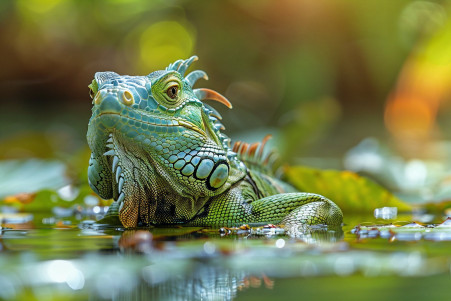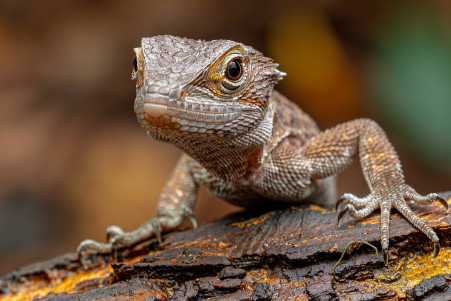Lizard Lifespan: Understanding How Long Different Species Live
19 March 2024 • Updated 19 March 2024

The story of the lifespan of lizards is one of extremes, from the briefest of moments to decades-long odysseys.
The lifespan of lizards is extremely diverse and can differ greatly between species; for example, the lifespan of the common house gecko is 10–15 years, chameleons can live up to 7 years, iguanas can live to be 20 years old, and Komodo Dragons have a lifespan of around 40 years. A lizard’s lifespan is determined by a variety of factors, including the environment, care, and species-specific characteristics.
In the sections below, we will take a deep dive into the worlds of herpetology and veterinary science to review studies that have investigated the lifespans of different species of lizards.
We will also look at how things like habitat, metabolism, and reproductive strategies play a role in how long they live. By the end of this article, we hope to have answered your questions and provided important information for lizard lovers and pet parents who want to improve the lives of these amazing animals.
How long do different species of lizards live?
Lizard Lifespan by Species
Lizard lifespans are as diverse as the many species that constitute the intricate mosaic of lizard existence. For example, the Merck Veterinary Manual explains that the green anole lives an average of 4 to 8 years, while the leopard gecko can live for more than 20 years. Meanwhile, the CK-12 Foundation reports that iguanas can live for up to 20 years, and the Komodo Dragon has an average lifespan of 20 to 40 years.
Genetic and species-specific factors play a critical role in determining these lifespans. A large-scale study published in Science and cited by the National Institute on Aging found that species-specific characteristics, including physical traits, are associated with lifespan.
For example, reptiles with armor, such as hard shells, tend to live longer than those without. This is consistent with the green iguana, which can live up to 15 years, and chameleons, which can live up to 7 years, as the green iguana is more physically robust and has a longer lifespan.
The diversity of lifespans among various species of lizards serves as evidence of the complexity of their biology and the evolutionary changes that have influenced their existence. It also highlights the numerous strategies that life has developed to endure and prosper in the animal kingdom.
Habitat and Lizard Longevity
The type of habitat a lizard lives in can have a major impact on how long it lives. A study in the journal PMC found that elevational gradients have an impact on lifespan, but the results were surprising.
For the lizard Psammodromus algirus, lifespan wasn’t a direct result of altitude, which is a common trend in ectothermic animals.
Instead, lizards in both the lowest and highest elevations, which are considered marginal habitats, had longer lifespans than those in the mid-elevation, which is considered an optimal habitat. The researchers suggested that the short activity window at the highest elevations and the low food availability at the lowest elevations were both factors in the longer lifespan.
In addition, research in ScienceDirect showed that human impact and other habitat disturbances have led to changes in lizard community structures, which has impacted their functional diversity and, in turn, their lifespan. The central-marginal hypothesis suggests that those in suboptimal habitats may live longer because of lower predation and interspecific competition.
These studies show how important it is to protect lizard habitats in order to ensure their longevity. By protecting a variety of habitats and keeping them as undisturbed as possible, we can help ensure ecological integrity and the health and longevity of lizard communities.
This is just one example of how the relationship between habitat and lifespan is complex and shows how much more there is to learn about lizard biology, including how metabolic rates impact longevity.
Understanding the Metabolic Mechanisms Behind Lizard Longevity
Metabolism is a key factor in the long life spans of ectotherms like lizards. Research published in ScienceDirect provides evidence for the rate-of-living hypothesis in lizards, showing that there is a negative correlation between energy expenditure and lifespan.
It has been shown in multiple studies that lizards with lower mass-specific metabolic rates tend to live longer. Furthermore, a study in Science that looked at ectotherms on a global scale found that protective traits like armor or venom, which may be related to specific metabolic adaptations, are linked to longer lifespans.
These traits are defense mechanisms that can lower predation and other risks, which in turn increases the likelihood that these reptiles will live longer.
Meanwhile, other results from the garter snake study, which was published in Integrative and Comparative Biology, show that differences in metabolic rates between closely related ecotypes have an impact on lifespan, which could be due to genetic or developmental differences.
Investigating the complex interplay between a lizard’s metabolism and its longevity shows how these ectotherms manage the trade-offs between energy use and lifespan. Clearly, their metabolic pathways have evolved in ways that are highly specific to their ecological niches, which begs the question of whether reproductive strategies have a similar impact on their longevity.
The Relationship Between Reproduction and Lifespan in Lizards
The reproductive behaviors of lizards present a particularly complex example of the relationship between reproduction and lifespan. A worldwide analysis in The American Naturalist shows that life-history traits in lizards, including reproductive behaviors, are heavily influenced by climate. This has led to differences in the way that lizards reproduce.
For example, tropical lizards tend to reproduce more often but with smaller clutches, which suggests a trade-off between reproductive output and lifespan. This is consistent with ecological theories that suggest that the evolution of repeated reproduction in less seasonal climates may lead to longer lifespans.
In arid environments, as explained by ScienceDirect, the differences in reproductive strategies can be even more pronounced between species. This is because reproductive traits, such as clutch size and viviparity (giving birth to live young), are linked to life span.
These traits are also linked to female size and body mass and are therefore important for survival. They may also determine the allocation of resources between survival and reproduction, which in turn will determine how long a lizard lives.
These differences in reproductive strategies show how the evolutionary pressures that have shaped lizard lifespans have also shaped the relationship between reproduction and lifespan. They also show how tenuous the balance between living long enough to reproduce and living long enough to ensure the survival of offspring can be. This understanding can also help us see how the relationship between reproduction and lifespan is shaped by biological and environmental factors.
The Fight for Survival: Health Risks in Lizards
Disease and parasites are two of the most common health risks that can lead to a lizard having a shorter life. A paper on ScienceDirect explains that fungal diseases are not only a direct threat to lizards but also have an impact on their social interactions. For example, the eastern water dragon has been shown to socially distance itself when it has a fungal disease, which changes the social structure of the population.
Meanwhile, a paper in Heredity found that resistance to diseases, like eye infections in juvenile common lizards, can vary greatly between families and populations, suggesting a strong genetic basis for disease resistance, which ultimately impacts the survival and life expectancy of lizards.
Meanwhile, the Merck Veterinary Manual explains that there are a number of health risks that are specific to captive lizards. These include respiratory infections, parasitic infections, and nutritional diseases, all of which can lead to a shorter life if they aren’t treated. As a result, it’s important to understand and address these health risks in both wild and captive lizard populations to ensure that they live long, healthy lives.
The Science of Lizard Longevity: A Recap
From metabolic rates to reproductive strategies, a number of biological and environmental factors contribute to the lifespan of lizards, and each factor has a unique impact on how long these reptiles will live. Species-specific traits determine the potential for longevity, with some lizards, like the Komodo Dragon, living longer than others, like the chameleon, which has one of the shortest lifespans.
Meanwhile, habitat quality and stability often determine the setting in which these factors will come into play, impacting longevity through a variety of ecological pressures.
Metabolic rates show the energy trade-offs that can help extend or shorten a lizard’s life, while reproductive strategies show the relationship between the energy a lizard uses to reproduce and the energy it uses to survive. Diseases and parasites show the health issues that can have a major impact on how long a lizard will live.
Not only does this information show how these factors work together, but it also has implications for conservation and caring for lizards as pets. By understanding how species-specific traits, habitat, metabolism, reproductive strategies, and health work together to determine how long a lizard will live, it becomes clear that more research is needed.
And as we work to better understand these factors, we also learn more about the delicate balance of life and the incredible ways that lizards have adapted to their place in the world.


